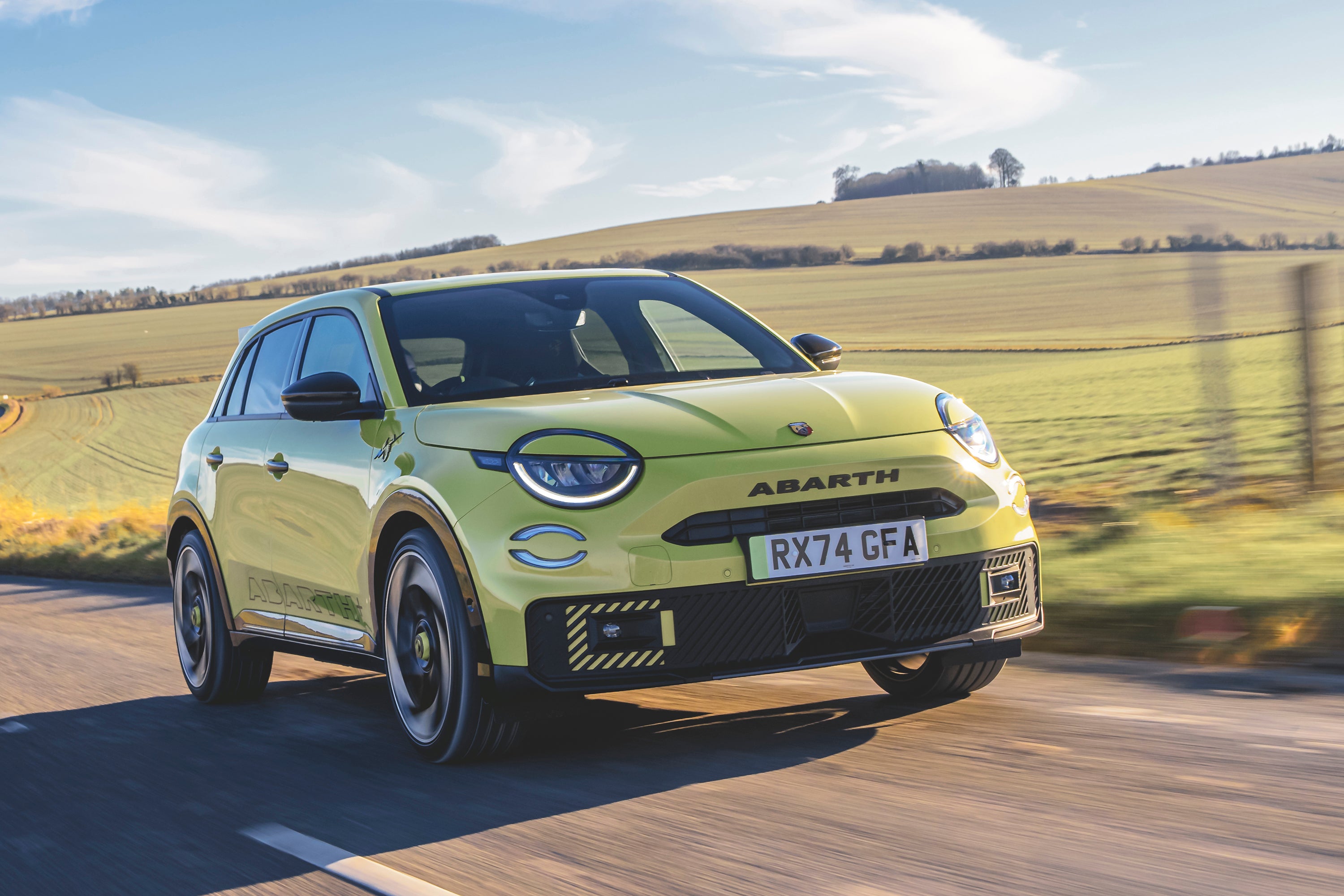Abarth 600e Review 2025: Price, specs & boot space
Written by Phill Tromans
- 2025
- Hot hatch
- EV
Quick overview
Pros
- Great fun to drive
- Striking looks
- Reasonable value
Cons
- Ride is a little firm
- Limited space
- Small battery range
Verdict: Is the Abarth 600e a good car?
"The Abarth 600e defied our expectations, carving out its own, riotous identity, which isn't easy to do when performance EVs struggle to stand out from the herd. It's flawed in a few ways, but get it on a twisty road, and you'll forgive all these."
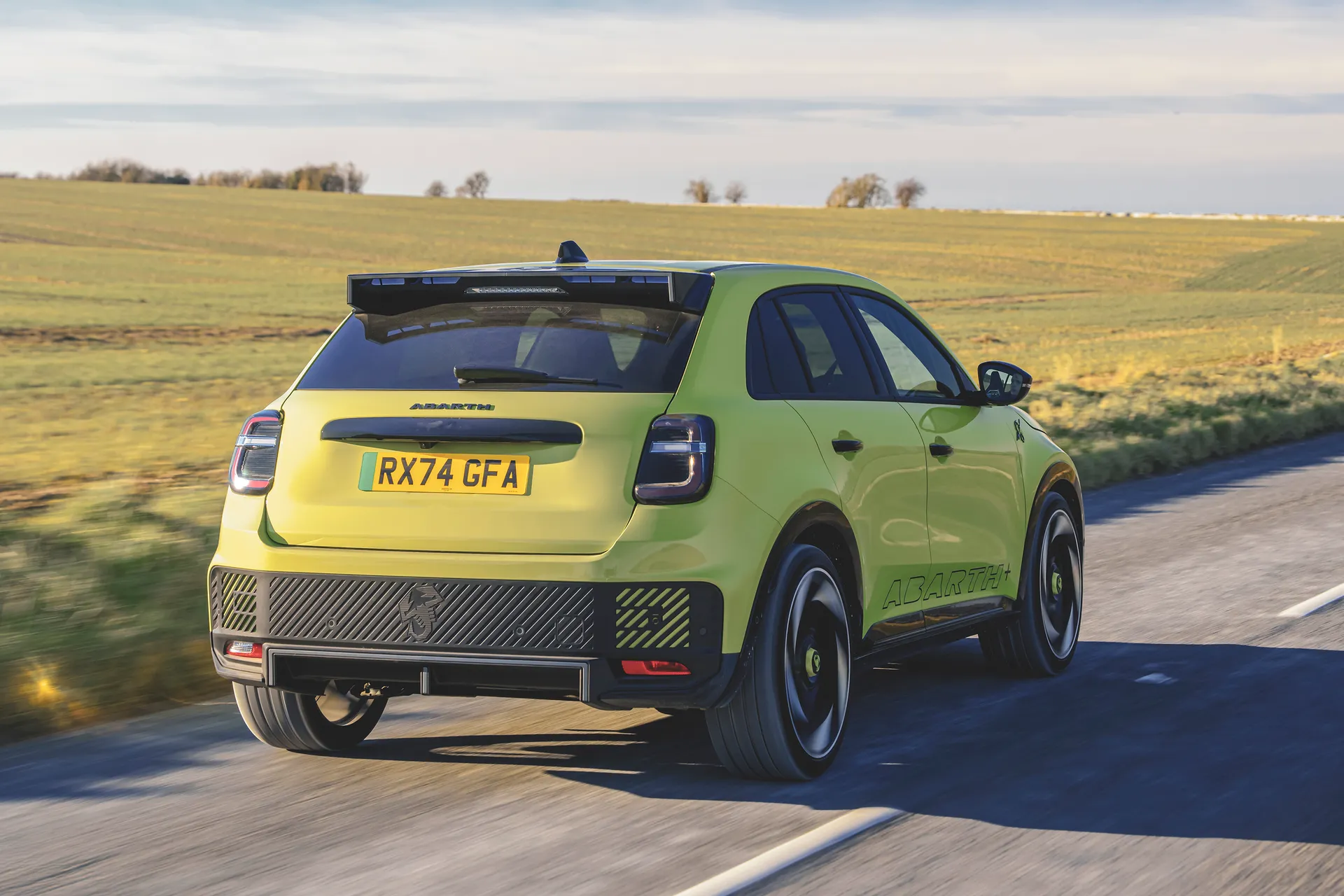
With the world going bonkers for electric cars and SUVs, it would be easy to fear that the days of the hot hatch are over. But the arrival of the Abarth 600e shows that they’re not; they’re just different. The Abarth 600e is its most powerful car ever, a spruced-up, souped-up Fiat 600e with a scorpion on the badge and a load of motorsport components bolted on.
Abarth’s recipe for cars is straightforward: take a Fiat and beef it up for smiles. It’s been doing this for decades with largely entertaining results; Abarths haven’t always been objectively good, but they’re almost always a hoot from behind the wheel.
For the Abarth 600e, Abarth has created two models. There’s the standard Abarth 600e, which has a 240PS electric motor driving the front wheels, and then there’s the Abarth 600e Scorpionissima, which is limited to 1949 units worldwide (the number representing the year Abarth was founded). As well as some extra features, it gets 280PS from its electric motor.
Both models have a specially made Torsen limited-slip differential for better handling, and big four-piston brake callipers made by Alcon, as well as hydraulic bump stops on the suspension dampers, which is technology taken from Abarth’s long history of rally competition.
The price? The standard car costs £36,975, while the Scorpionissima is £41,975. We've driven both versions on the international launch, and the Scorpionissima at a UK driving event. Based on what we've experienced thus far, we’d say that while the Scorpionissima is more fun, it’s not by such an amount that would justify the price rise unless the jazzier interior and extra safety features are particularly attractive to you.
heycar has 1000s of used cars for sale, including a wide range of Abarth 600e cars for sale.
Is the Abarth 600e right for you?
The Abarth 600e is one of the most fun-to-drive electric cars of this type, feeling more agile and alert than the MINI Aceman. It’s quicker, too – even the standard Abarth 600e has more power than the most powerful Aceman. While exterior design appreciation is subjective, we think the Abarth 600e is a looker, too. If those are priorities for you, then happy days – this is a fun machine to drive with all the benefits that come with electric car ownership.
However, when it comes to space – both in the back for passengers and in the boot for luggage – it lags behind the best in the class. If you regularly need lug around people and/or stuff, then check out the Volkswagen ID3 GTX or, if you’re not set on electric power, the petrol-fuelled Ford Puma.
What’s the best Abarth 600e model/engine to choose?
In terms of outright driving fun, the Abarth 600e Scorpionissima is the most appealing thanks to its 40 extra horsepower and fancier interior. It gets a sound generator too – more on that shortly.
However, going for the top-spec model will cost you quite a bit extra. Its limited-edition status may also make it tricky to find, depending on how popular it turns out to be. If you want the full Abarth experience then the Scorpionissima model is definitely the one to go for, but unless you really want the jazzy extra bits and the improved front seats, save your £5000 and go for the standard car, as most of the motorsport-derived performance components are still included.
What other cars are similar to the Abarth 600e?
Other performance-focused and fun-to-drive electric cars of this type include the Alfa Romeo Junior Veloce, with which the Abarth 600e shares some components, and the MINI Aceman, as well as the Volkswagen ID.3 GTX, Cupra Born VZ and the MG4 X Power.
The Aceman is more of a “fun for a normal car” than a proper performance model, while the Cupra and VW are pricier than the Abarth. The MG is closer in price and has bags more power, but it doesn’t feel as rounded in terms of the driving experience.
The closest rival in price and performance is the Alfa Romeo, and good as it is, it’s not quite as fun as the Abarth.
Comfort and design: Abarth 600e interior
"The Abarth 600e's interior zings up the standard Fiat setup with some fancy graphics. It's not particularly swanky, but it's perfectly acceptable for a car of this type."
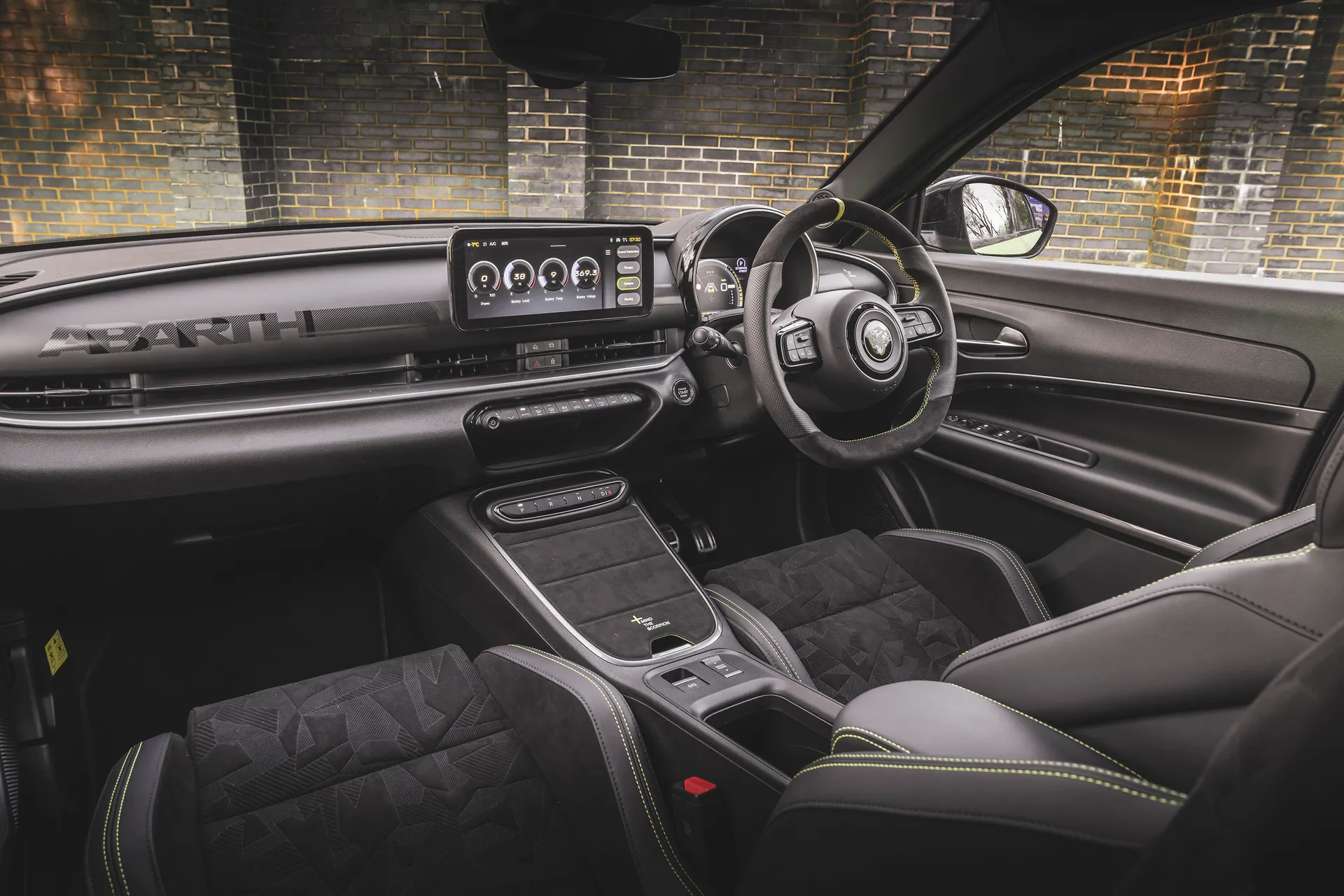
Much of what we said about the standard Fiat 600e carries over to the Abarth model, because not much has changed. It’s not especially premium, but it doesn’t feel cheap, either – there are some nice rounded lines and the big Abarth print on the dashboard in front of the passenger seat reminds you that this isn’t just a Fiat.
The standard Abarth 600e gets some stylish, comfortable, manually adjusted sports seats adorned with some fancy graphics (ABARTH SCORPION PERFORMANCE, our test car proudly proclaimed), while the Scorpionissima gets extra-supportive bucket seats that really hold you in place through the corners and adjust electrically. If you plan on some very enthusiastic driving then perhaps the upgrade is worth the extra cash.
Quality and finish
The materials used in the Abarth 600e aren’t exactly premium – the plastics are rather hard to the touch – but they’re inoffensive enough. Everything feels solid and well put together.
Infotainment: Touchscreen, USB, nav and stereo in the Abarth 600e
The Abarth 600e has a 7.0-inch digital instrument display behind the steering wheel and a 10.25-inch infotainment screen. It’s basically the same as the one that you’ll find in the Fiat version of this car, and that’s not a bad thing; it’s easy to use and quick to respond to your touch, although a few features are somewhat buried away in the menus.
Wireless Apple CarPlay and Android Auto are included, and Abarth extras include performance-related gauges, including a G-meter. There are USB A and C sockets in the front and the back to charge devices, and both versions feature a six-speaker sound system.
Space and practicality: Abarth 600e boot space
Space isn’t the Abarth 600e’s strong suit. While up front driver and passenger will have no issues, rear seat space is tight. Legroom is very limited; two adults will fit in the back, but they’ll be complaining of cramp fairly quickly. The middle seat is even more squashed up. There are few practicality additions in the back, either – no door pockets, no pockets in the back of the front seats and no cup-holders. Still, headroom is ok.
The boot isn’t massive, either. OK, it’s a small car, but the capacity behind the back seats is unspectacular compared to rival cars. At 360 litres it’s around 25 litres smaller than the Volkswagen ID.3 GTX, and if you’re looking for non-electric fun cars, it’s considerably smaller than the 456 litres you get in a Ford Puma.
On the plus side, storage up front is pretty decent, with a big covered storage area under the centre of the dashboard, reasonably sized door pockets and a deep area between the front seats with adjustable cup holders. There’s more storage under the centre armrest, too.
Handling and ride quality: What is the Abarth 600e like to drive?
"For all the nitpicks we’ve mentioned about the Abarth 600e, the driving experience is its party piece – it’s a cracker. This was reinforced when we spent additional time in the car on UK roads a few months on from the international launch, but this did reveal that the ride is quite firm."
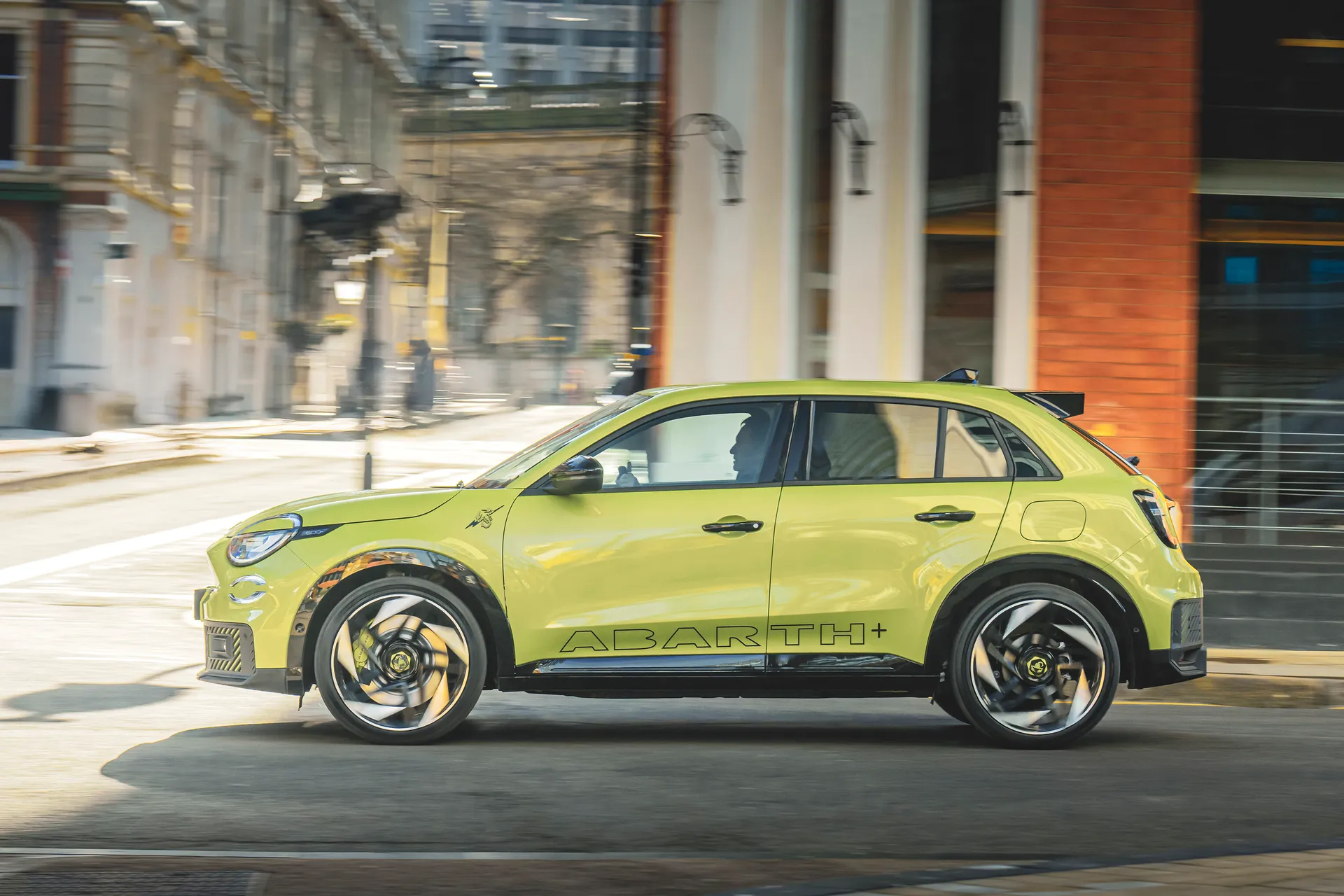
There’s lots to like about being behind the wheel of the Abarth 600e. The electric motor makes for punchy acceleration in both the standard car and the Scorpionissima, and it feels faster in its gathering of speed than the raw numbers would have you believe (6.2 seconds in 600e, 5.9 seconds in the Scorpionissima).
But it’s the handling that sets the Abarth 600e apart. The steering is direct and precise, heavy enough to inspire confidence, and the Alcon brakes are powerful and full of feel. In Track mode, there’s no energy regeneration when you brake, which gives it a purity that’s important for track driving – if you want to take a (relatively) affordable electric car to a track, this should be on your shortlist.
There’s loads of grip, too, from the sporty Michelin PilotSport tyres, and when the grip does start to run out the Abarth 600e feels very predictable and adjustable through both the accelerator and the steering. Its agility and poise is helped in large part by the standard-fit Torsen mechanical limited-slip diff, which succeeds superbly in harnessing torque under acceleration and sending it to the best wheel to keep things tidy.
In short, the Abarth 600e is great fun; not perhaps as frisky as some of the most entertaining hot hatches, more clinical, but it’s engaging and entertaining.
In the UK, the car reveals a slightly scrappier side, with a noticeable sensation of torque steer (when the car pulls in one direction or another under acceleration) over rough surfaces, but that merely made the Abarth more fun. It's not as 'clinical' as other fast EVs - there's fun in the imperfection. If it had more power and was all-wheel drive instead of front, it wouldn't be as entertaining.
On the other hand, our UK drive did show that the low-speed ride is particularly firm, so you'll be wanting to take it easy over speed bumps and avoid speed bumps as much as is possible given the state of the asphalt on our shores. It does settle at speed, but particularly bumpy B-roads will see the car bounce around quite a bit.
What motors and batteries are available in the Abarth 600e?
The Abarth 600e comes with a 54kWh battery and an electric motor that pushes out 240PS in the standard car and 280PS in the Scorpionissima. It’s pretty difficult to tell the difference between them in terms of acceleration, with only 0.3 seconds between them in the sprint to 62mph. Both will charge at up to 100kW with a suitable fast charger, taking just under 30 minutes to refill the battery from 20% to 80% capacity.
Abarth 600e range: How far can you travel on a charge?
The battery range is unremarkable – up to 207 miles per charge, which when the Cupra Born VZ promises up to 372 miles isn’t particularly impressive. During the UK launch event, we averaged just 1.9 miles per kWh, which would drop this 207-mile figure significantly, although much of the driving was of the, erm, spirited kind. A more realistic mix of driving and you should get a little more out of the Abarth, although probably not the full 207 miles of quoted range.
Refinement and noise levels
In the 600e wind and road noise are entirely acceptable, if not quite as hushed as we might like. Meanwhile, the suspension is well-tuned to keep at least reasonable lumps and bumps out of the cabin, even if the going can get a bit choppy over some surfaces.
We should mention the car’s artificial noise generator. Abarth decided that a performance car should sound like it has an engine, even though it doesn’t have one. So, linked to the accelerator, is essentially a sound system, with speakers under the car booming out an approximation of a performance petrol engine.
Whether or not you like this will be down to you. We didn’t care for it; it doesn’t sound like a real engine, more like someone playing a CD of engine sounds too loudly inside the car. So what’s the point? The fun of driving the Abarth 600e is more than sufficient, and it doesn’t need this kind of gimmick.
At the very least, Abarth has used lessons learned with the similar system in the 500e and turned the volume down a bit, especially at cruising speeds, so it does work better here. But still, we'd probably prefer to leave it off.
Safety equipment: How safe is the Abarth 600e?
The Abarth 600e hasn’t yet been assessed by independent safety organisation EuroNCAP. However, it does come with a solid spread of standard safety equipment, including a system that detects if the driver is getting drowsy as well as automatic emergency braking, lane-departure warning and front, side and rear parking sensors, as well as a six airbags and Isofix child-seat mounting points on the outer rear seats and the front passenger seats.
The Scorpionissima model adds adaptive cruise control and a blind-spot warning system.
Charging times: How much does it cost to charge the Abarth 600e?
"Both versions of the Abarth 600e use the same battery and can charge at up to 100kW if you find a suitable fast charger. This means that a charge from 20% to 80% capacity takes around 27 minutes."
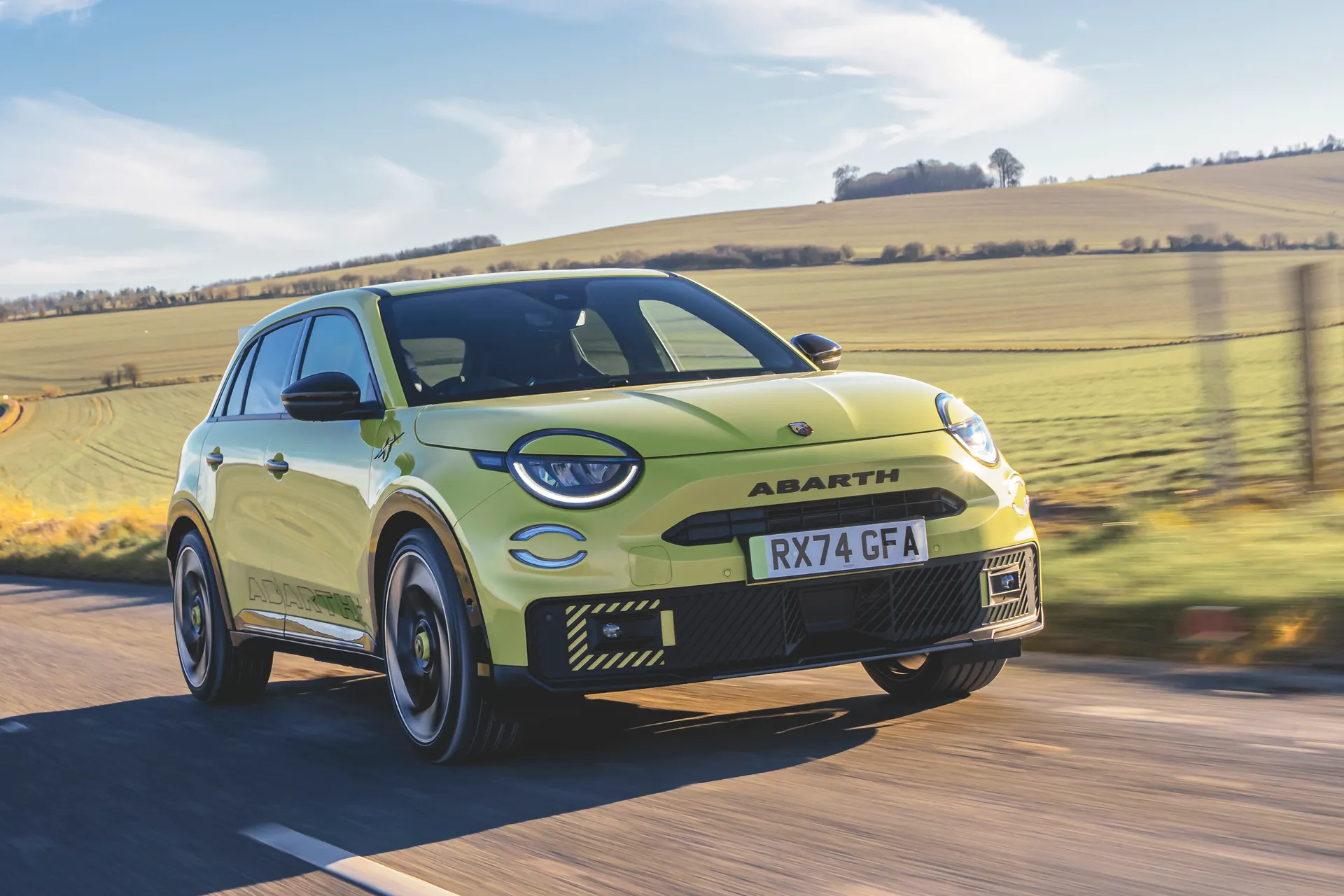
This speed is broadly comparable to rival cars. How much it costs you to recharge will depend on where and when you do it. Plug in at home overnight on a suitable electricity tariff and a 7kW home charger will top up the battery from 20% in just over six hours at a cost of around £11.
Public chargers will be faster, but cost more – expect to pay around £30 to charge from 20% to 80% assuming a rate of 70p per kWh.
Abarth 600e reliability and warranty
The Abarth 600e is brand new, so we don’t have any meaningful data about its reliability. But cars from parent company Stellantis has shown very decent reliability in recent years, so we have no real reason to suggest that the Abarth 600e will have particular issues. While a look at the HonestJohn.co.uk Satisfaction Index highlights Fiat’s poor position in the manufacturer rankings, that’s almost entirely due to the rather old 500, which shares no parts with the 600e.
Electric cars generally tend to have fewer problems than equivalent petrol or diesel models, because there are fewer moving parts to go wrong.
Abarth 600e insurance groups and costs
The standard Abarth 600e has an insurance group of 35 out of 50, while the more powerful and expensive Scorpionissima sits in group 36. This means that while insurance premiums won’t exactly be cheap, they won’t be horrendous either. In comparison, the VW ID.3 GTX sits in group 34, so there’s little difference to the main competition.
VED car tax: What is the annual road tax on an Abarth 600e?
As an electric vehicle, the Abarth 600e costs nothing in Vehicle Excise Duty at the time of writing, but that will soon change. From 1 April 2025 the rules around taxing a car will be updated, and electric cars will cost the same as petrol and diesel cars. Abarth 600e owners will be liable for the standard annual rate, which is currently £190 but could go up.
Thankfully, Abarth has tweaked the price of the 600e Scorpionissima so it escapes the government's £410 annual 'premium car' supplement, saving owners a packet over years two to five of ownership.
Abarth 600e price
"As the Abarth 600e is brand new there are no used models on the market yet. When new, the 600e costs from £36,975 for the standard model, while the 600e Scorpionissima costs from £39,875."

In comparison, the Cupra Born VZ costs from £44,570, although it's got more power and much-improved battery range. The Volkwagen ID.3 GTX is even more, starting at £45,345, and has similar power to the top-spec 600e. It's not as much fun to drive, though.
Trim levels and standard equipment
The range of the Abarth 600e is simple. There are two versions: the standard 600e and the 600e Scorpionissima.
The standard car comes with the 240PS electric motor and rides on 20-inch diamond-cut alloy wheels with a central hubcap designed to look like the wheel nut on a racing car. LED headlights, running lights and rear lights are standard, and there’s a sporty body kit to differentiate it from the Fiat 600e.
Inside there are Sabelt sports seats that adjust manually and are upholstered with fabric, automatic air conditioning and a keyless entry and start system.
Upgrade to the Scorpionissima and as well as 40PS extra in power, you’ll get tinted rear windows and some extra exterior embellishments, as well as a rear-view camera and power folding mirrors and the external sound generator.
Inside, the seats are more racing inspired, with extra lateral support, and they adjust electrically. The boot lid opens electrically, the steering wheel is clad in Alcantara (synthetic suede) and there’s a heated windscreen for icy mornings. The extra safety features mentioned earlier are also included.
Ask the heycar experts: common questions
How fast is the Abarth 600e?
What is the range of the Abarth 600e?
How expensive is the Abarth 600e?
Get our latest advice, news and offers
Keep me updated by email with the latest advice, news and offers from heycar.
By submitting you agree to our privacy policy
